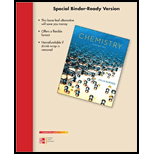
Concept explainers
Interpretation:
The name of the given compound is to be identified.
Concept introduction:
In chemical nomenclature, the
The parent chain is the longest continuous chain of carbon atoms.
If the same substituent occurs more than once, the location of each point on which the substituent occurs is given.
If there are two or more different substituents, they are listed in alphabetical order using the base name
Primary
The ending
The parent chain is numbered from the end that is closest to the substituent.
The position and identity of the substituent is indicated by a number and a prefix.
Want to see the full answer?
Check out a sample textbook solution
Chapter 25 Solutions
Chemistry - With Access (Looseleaf) (Custom)
- Which of the following functional groups are present in 3-nitroaniline? Group of answer choices 1° amine amide para-disubstituted phenyl ketone 2° amine 3° amine aldehyde meta-disubstituted phenyl alkene nitro alcohol hydroxyl ortho-disubstituted phenyl ester alkyl etherarrow_forwardWrite reaction of ethylmethylamine with the following reagents: a. HNO3 b. CH3COClarrow_forwardWhat amide(s) form amine X on treatment with LiAlH4?arrow_forward
- Draw the structure of the following compounds: (1) (2S,4S)-2-ethyl-4-hydroxycyclopentan-1-one (2) (3E)-N,N-dimethyl-5-oxohex-3-enamide Please answer botharrow_forwardWhat is the correct name for the following compound? Option 1: N-ethyl-N-methyl-1-oxopropanamine Option 2: 1-(ethylamino)-1-(methylamino)propanone Option 3: N-ethyl-N-methylpropanamide Option 4: ethylmethyl propanamide Option 5: 1-(ethylamino)-1-(methylamino)propanalarrow_forwardHow would you prepare the following substances from pentanoic acid? a. Pentanamide b. Butylamine c. Pentylaminearrow_forward
- What functional group(s) are needed to synthesis the following products (CHOOSE ALL THAT APPLY)Please include the letters with the answers. a. tertiary alcohol b. amide c. primary alcohol d. aldehyde e. secondary alcohol f. carboxylic acid g. aromatic h. ketonearrow_forwardDraw the organic product formed when the following com-pounds undergo a substitution reaction: (a) acetic acid and methylamine; (b) butanoic acid and 2-propanol; (c) formic acidand 2-methyl-1-propanol.arrow_forwardWhat are the derivate reagents for the following compound: MDMA (N-methyl-N-trifluoroacetyl-3,4-methylenedioxyamphetamine)?arrow_forward
- What is the name of the product? (look at the picture to be able to answer) a) propionate b) 1-ethylpropanoic acid c) 1-ethylpropanal d) propanoic acid e) ethanol f) 3-ethylpropionate g) None of the answers are correct.arrow_forwardWhat is the structure ,melting point,boiling point ,molecular weight and molecular formula for 2,4 dinitrochlorobenzen, 2,4 dinitrophenylaniline and 2,4 dinitrochloroaniline thank u just want these i just put a blank pic coz it doesnt submitarrow_forwardidentify the error in each name. Then correct the name. a. 2-pentanal b. N,N-diethyl-N-methylpentanamidearrow_forward
 Organic ChemistryChemistryISBN:9781305580350Author:William H. Brown, Brent L. Iverson, Eric Anslyn, Christopher S. FootePublisher:Cengage Learning
Organic ChemistryChemistryISBN:9781305580350Author:William H. Brown, Brent L. Iverson, Eric Anslyn, Christopher S. FootePublisher:Cengage Learning
 Chemistry: An Atoms First ApproachChemistryISBN:9781305079243Author:Steven S. Zumdahl, Susan A. ZumdahlPublisher:Cengage Learning
Chemistry: An Atoms First ApproachChemistryISBN:9781305079243Author:Steven S. Zumdahl, Susan A. ZumdahlPublisher:Cengage Learning
 ChemistryChemistryISBN:9781305957404Author:Steven S. Zumdahl, Susan A. Zumdahl, Donald J. DeCostePublisher:Cengage Learning
ChemistryChemistryISBN:9781305957404Author:Steven S. Zumdahl, Susan A. Zumdahl, Donald J. DeCostePublisher:Cengage Learning Introduction to General, Organic and BiochemistryChemistryISBN:9781285869759Author:Frederick A. Bettelheim, William H. Brown, Mary K. Campbell, Shawn O. Farrell, Omar TorresPublisher:Cengage Learning
Introduction to General, Organic and BiochemistryChemistryISBN:9781285869759Author:Frederick A. Bettelheim, William H. Brown, Mary K. Campbell, Shawn O. Farrell, Omar TorresPublisher:Cengage Learning





